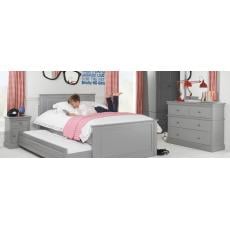
A bedroom is such an important space, so it is crucial that it is also a happy space. We all spend a lot of time in our bedrooms - children included. It is definitely worth putting in the effort to make sure your child’s bedroom is a calm and happy space for them. In the list below, five simple design elements are explored that can be used to create a bedroom that your child will enjoy and feel content within:
-
Colour Therapy
Children’s moods are affected by their environments, and that massively includes the colours used in their rooms. Mood and colour are very strongly linked so it is important to think carefully about the colours you include in your child’s bedroom.
The science of colour and its effects has been in use for a long time - for example, yellow is scientifically considered a very happy colour. Therefore, choosing the right colour scheme can help make a room feel like a happier place, so give the colours you use great consideration.
-
Declutter
“A cluttered room is much more likely to produce, and contribute to, a cluttered mind,” states professional organizer Marie Kondo, creator of the KonMari method. It has been proven that visual clutter negatively impacts mood in a variety of ways, including increasing stress, anxiety, and depression. Maintaining a clutter-free space is, therefore, crucial to creating a positive and tranquil atmosphere in a bedroom.
Too many visual elements will overstimulate your child’s brain, so it is important to create a space that is free from clutter. Use storage creatively and effectively to keep your child’s room neat and tidy. Constantly work with your child to throw/give away any items in their room that they no longer use or like, that way the number of items in their room will always be kept to a minimal.
-
The Right Bed & Bedding
A bad night’s sleep will leave your child feeling cranky, irritable, and unfocused. Good sleep is crucial to having a clear and happy state of mind. It is therefore important to prioritise your child’s bed and bedding when designing their bedroom.
Visually, a bed is generally the largest piece of furniture and the focal point of a bedroom. So it makes sense to choose a bed and linen that will put a smile on your child’s face and provide them with a comfortable and happy place to sleep. Physically, your bed and bedding have a huge impact on your mood, health and wellness by impacting how well you sleep. Soft textures and a comfortable bed will create a better environment for sleeping.
-
Consider Personality
When designing a space that will be the happiest one for your child, it is important to consider their personality. Making sure their bedroom aligns well with their personality is key to them feeling happy and secure in the space. Children who are more extroverted feed off the world around them so they can enjoy a more sensory-rich environment. Introverted children, on the other hand, have a rich inner world so they should have a more carefully curated space.
Introverts are more sensitive to visual stimuli than extroverts, so they should have a more relaxing environment. So remember when choosing patterns and colours that bold ones will stimulate extroverts but overwhelm introverts. Introverts perceive and process the sensory information around them a lot more than extroverts, and extroverts perceive only some of it so they are able to handle a lot more.
-
Light
Mood and light are very strongly linked. Psychologists have known the effect that light has on our emotions for many years. So choosing the type of light for your child’s bedroom should be a serious consideration. Warm light with warm light bulbs is more inducive for relaxing and communication so it is much preferred for bedrooms over cool light.
Natural light is great for our mood. Sunshine has been proven to be a powerful mood-lifter that also helps set our circadian rhythms. Therefore, make sure to open the curtains in your child’s bedroom during the day and keep the windows clean to let all the sunshine in.
Considering these five points when designing your child’s bedroom will maximise the happiness they will feel each day. Your child’s sanctuary should leave them feeling calm and happy and they should enjoy being in their space - and hopefully, with these five tips, you will be able to achieve just this!
